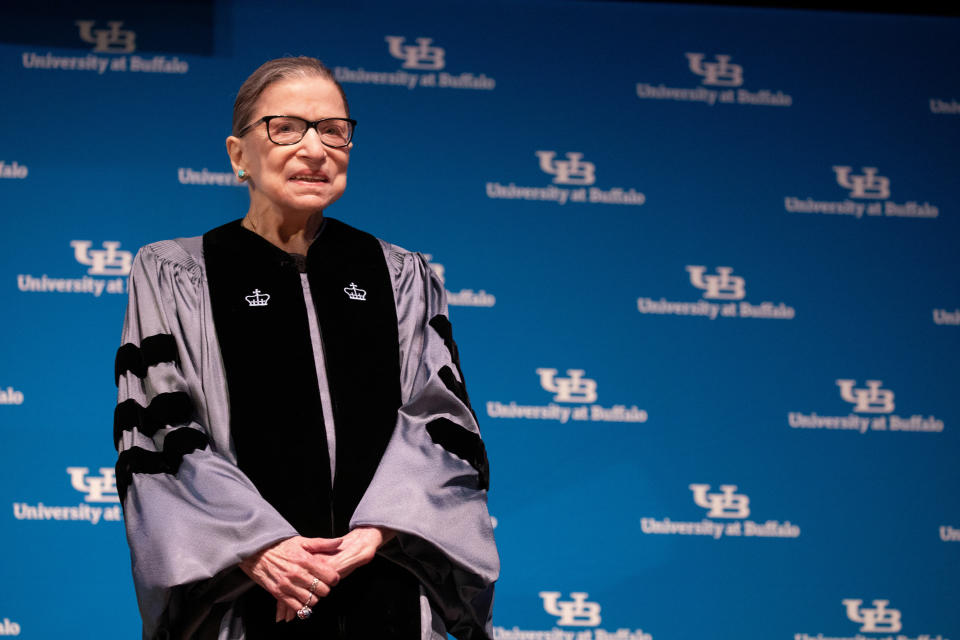Supreme Court Justice Ruth Bader Ginsburg dead at 87
Supreme Court Justice Ruth Bader Ginsburg, one of the court’s four liberal justices, died Friday evening, the court announced in a statement.
Ginsburg, who was nominated by President Bill Clinton in 1993, was 87 years old and in delicate health for some months, although she had kept up a full schedule on the bench. She was hospitalized earlier this year with a recurrence of metastatic pancreatic cancer, which was first detected in 2009, and that was listed as the cause of her death.
Shortly before she died, Ginsburg dictated a statement to her granddaughter, Clara Spera. “My most fervent wish is that I will not be replaced until a new President is installed,” she wrote.
The decision to fill the court vacancy now enters the hyperpartisan atmosphere of the 2020 presidential race, with just weeks before the Nov. 3 election.
PHOTOS: Justice Ruth Bader Ginsburg — A look back
President Trump was speaking at a campaign rally in Minnesota when Ginsburg’s death was announced, and he evidently only learned about it from a reporter only as he was leaving. “I didn’t know that,” he said. “She led an amazing life. Whether you agreed with her or not, she was an amazing woman who led an amazing life. I’m actually saddened to hear that.”
Trump will now have the opportunity to nominate his third Supreme Court Justice. Senate Majority Leader Mitch McConnell made clear he intended for the Senate to fill Ginsburg’s seat while Trump was still president.
“President Trump’s nominee will receive a vote on the floor of the United States Senate,” McConnell said in a statement Friday.
In February, McConnell vowed that if a Supreme Court seat opened up this year, “we would fill it.”

In 2016, McConnell refused to bring up President Barack Obama’s nominee, Merrick Garland, for a vote to fill the seat left vacant by the death of Justice Antonin Scalia, with the justification that “this nomination ought to be made by the president we’re in the process of electing this year.”
Senate Minority Leader Chuck Schumer echoed McConnell’s words in a tweet Friday voicing his opposition to having the Senate consider a new Trump nominee before Inauguration Day.
The American people should have a voice in the selection of their next Supreme Court Justice. Therefore, this vacancy should not be filled until we have a new president.
— Chuck Schumer (@SenSchumer) September 18, 2020
After his election to the presidency later in 2016, President Trump nominated Neil Gorsuch, another conservative, to fill the vacancy. Gorsuch’s nomination was confirmed by the Senate in April 2017.
In a speech in 2018, McConnell recounted that “one of my proudest moments was when I looked Barack Obama in the eye and I said, ‘Mr. President, you will not fill the Supreme Court vacancy.’”
On Sept. 9, President Trump announced a number of new names to his long list of possible Supreme Court nominees, including Republican Sens. Ted Cruz of Texas and Tom Cotton of Arkansas.
While it remains to be seen whether Trump will try to fill Ginsburg’s seat before the end of the year, Sen. Lisa Murkowski, R-Alaska, told reporters that she would not confirm a new justice until after a new president is inaugurated next January.
Republicans still control the Senate with a slim 53-47 majority. But Ginsburg’s death will now become a dominant issue heading into the election, and it’s certain to mobilize liberal and conservative voters alike heading into November.
Throughout her career, Ginsburg was a leading advocate for gender equality and civil rights.
“Women’s rights are an essential part of the overall human rights agenda, trained on the equal dignity and ability to live in freedom all people should enjoy,” she said.

After growing up in Brooklyn, Ginsburg attended Columbia Law School, graduating in 1959 at the top of her class. She went on to take a job at Rutgers Law School in 1963 and received her first judicial appointment in 1980.
Some of Ginsburg’s most notable cases sought to level the playing field for women, including 1996’s United States v. Virginia, which barred the Virginia Military Institute from excluding women at the college.
“Neither the goal of producing citizen soldiers nor VMI’s implementing methodology is inherently unsuitable to women,” Ginsburg wrote in the majority opinion.
During the oral arguments for Obergefell v. Hodges, the 2015 case that would legalize same-sex marriage in all 50 states, Ginsburg’s forceful questioning of the attorneys seeking to uphold a ban in certain states is cited as a key factor in the court’s verdict.
The 2016 case Whole Woman’s Health v. Hellerstedt overturned strict measures in a Texas law (known as H.B. 2) to curtail access to abortion.
“It is beyond rational belief that H.B. 2 could genuinely protect the health of women, and certain that the law would simply make it more difficult for them to obtain abortions,” Ginsburg wrote. “When a State severely limits access to safe and legal procedures, women in desperate circumstances may resort to unlicensed rogue practitioners ... at great risk to their health and safety.”
_____
Read more from Yahoo News:



